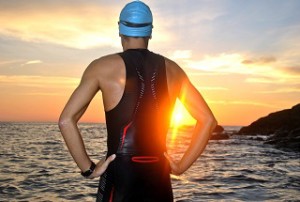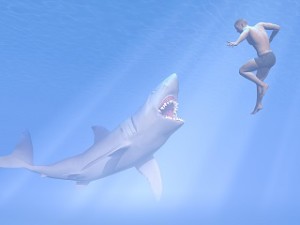9 Tips for Successful Open Water Swimming for Triathletes
‘Tis the season for triathlons. You’ve been putting in hours at the pool, refining your technique, improving efficiency, and gaining endurance and speed. Now it’s time to transition to the open water. Here’s a few tips for successful open water swimming for triathletes to get you into the lake or ocean while conserving energy and boosting your confidence.

Get in the Water and PRACTICE!
The more you can get in the open water, the better. There’s no black line to follow and if you’re lucky, you might be able to see your hands. In most instances, you can’t touch the bottom and there’s no wall to push off. You have to navigate on your own while keeping in mind all that technique you’ve practiced in the pool. It’s ideal to practice in a group so you get used to drafting and bumping into people/elbows/feet without it bothering you.
So grab your training buddies and get out to the open water. If you’re not comfortable yet, have a friend (or coach!) kayak or paddleboard alongside you until you gain confidence. There are additional open water skills that you can practice in the pool too, like sighting (see below), swimming with your eyes closed, drafting and more. Plus, if you need to get in your wetsuit, you’ll need to practice in it before race day.
Wear a Swim Cap
Generally this isn’t an issue for women, but most men I train don’t wear a cap in the pool. Not only are they required in races, but they make you visible to any boaters or other people who may not be expecting to see swimmers. Plus, you tend to retain heat with it on, so be sure you get used to swimming with a cap so you know what to expect on race day. I usually recommend wearing your goggles under your cap so there’s no danger of losing them or having them get knocked off. But do what feels comfortable for you.
Don’t Forget to Warm Up
You should always be doing a dynamic land warm up as well as a warm up in the open water (or pool, for that matter). Get acclimated to the taste, smell and temperature of the water. Plus, you’ll ensure a good seal with your goggles, make sure you’re wetsuit isn’t rubbing and that the rest of your gear is ready to go.
Learn to Sight
You just pop your head out of the water to see where you’re going, right? Not so much…unless you want a faceful of water from a wave or splash from the swimmer in front of you. Sighting is a technique where you barely sneak your goggles out of the water, keeping your nose and mouth in the water. Think of it as “alligator eyes.”
You just need to peek out of the water to check on your direction. If you don’t see what you were expecting at first, take a few more strokes until you can sight again. It’s a bit of a balancing act: you don’t want to go off course, but you don’t want to have your head lifted too often, creating more drag and decreasing efficiency. Practice in the pool by closing your eyes, taking 6-8 strokes and standing up to see if you tend to swim to the left or right (unless you hit the lane line first). Then add your alligator eyes at least one stroke before you take a breathe. It’s all about rhythm. Find yours. Then practice. I mentioned that already, right?
Learn to Breathe on Both Sides
Also known as bilateral breathing, it’s important to keep your body balanced. Not to mention, it’s great for navigating and (that little thing otherwise knows as) oxygen. Say you’re swimming alongside a “splashy” swimmer or the water is choppy. Try to take a breath facing the waves or unruly swimmer and you’ll inhale the water. If you breathe to the opposite side, no problem. You can navigate by looking at the shoreline, landmarks or sun to help guide you without having to constantly sight. Again, this should be practiced in the pool.
Find a Calming Mantra
Is this you in the open water?

If you’re one to get a little antsy about possible things lurking in the water, well…your worries aren’t unfounded. Yes, there are possibly fish, jellyfish, random bits of trash, seaweed and various other things that may not be in the pool. However, if you’re swimming smart (don’t be the genius who swims in the ocean at dusk with a sparkly ring), you’ll likely be fine.
Most things in the water don’t want to have anything to do with you.
Regardless of whether it’s the things that “go bump in the water” that give you the heebie-jeebies or if it’s just general anxiety, have a your calming mantra. Whether it’s as simple as telling yourself “breathe” or “relax” or “stretch,” repeat it often to keep you calm. Other people like to sing or count to themselves. Find what keeps you focused, relaxed and centered.
Practice Start and Finish Skills
If you’re not trying to break any records, just get in and go (at least wade to thigh deep water before starting). But if you’re looking for a few extra seconds, practice start and exit techniques (which includes removing that giant rubber suit). And know that your heart rate will be higher with a fast start, so control your breathing and relax into your stroke.
Be Strategic & Know the Course
Before any open water swim or race, evaluate the water, the course and the weather conditions. Learn the course and what you’ll need to be sighting all around you. If the current is pulling hard in one direction, should you try to swim in the opposite direction to get you straight (hint: YES)? What’s your skill level? In a race, decide whether you want to be in the front, off the back, to the sides or smack dab in the middle. How do you deal with aggressive swimmers or are you the aggressive swimmer? Do you prefer to pass or be passed? Which side do you prefer to breathe? Think about these things before you jump in and you’ll be on your way to a good race.
Have an Emergency Stroke
No one plans on getting kicked in the gut, splashed in the face, or otherwise freaked out in the water. If something unexpected happens, have an “emergency stroke” you can default to. Maybe it’s elementary backstroke, sidestroke, or breaststroke. Stay calm, get your bearings, ask for help if you need a break, then move on.
Good luck in your next triathlon, SwimRun or open water swim!
Want to be a better open water swimmer for triathlon?
We GOT YOU!
Check out our Group Triathlon Training Program, where we regularly swim in the open water from April to October as part of our group workouts/classes and clinics.




